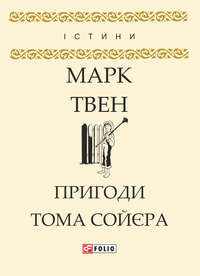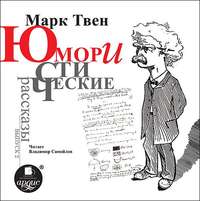 полная версия
полная версияFollowing the Equator: A Journey Around the World
Then we struck into the hot plain, and found the roads crowded with pilgrims of both sexes, for one of the great religious fairs of India was being held, just beyond the Fort, at the junction of the sacred rivers, the Ganges and the Jumna. Three sacred rivers, I should have said, for there is a subterranean one. Nobody has seen it, but that doesn’t signify. The fact that it is there is enough. These pilgrims had come from all over India; some of them had been months on the way, plodding patiently along in the heat and dust, worn, poor, hungry, but supported and sustained by an unwavering faith and belief; they were supremely happy and content, now; their full and sufficient reward was at hand; they were going to be cleansed from every vestige of sin and corruption by these holy waters which make utterly pure whatsoever thing they touch, even the dead and rotten. It is wonderful, the power of a faith like that, that can make multitudes upon multitudes of the old and weak and the young and frail enter without hesitation or complaint upon such incredible journeys and endure the resultant miseries without repining. It is done in love, or it is done in fear; I do not know which it is. No matter what the impulse is, the act born of it is beyond imagination marvelous to our kind of people, the cold whites. There are choice great natures among us that could exhibit the equivalent of this prodigious self-sacrifice, but the rest of us know that we should not be equal to anything approaching it. Still, we all talk self-sacrifice, and this makes me hope that we are large enough to honor it in the Hindoo.
Two millions of natives arrive at this fair every year. How many start, and die on the road, from age and fatigue and disease and scanty nourishment, and how many die on the return, from the same causes, no one knows; but the tale is great, one may say enormous. Every twelfth year is held to be a year of peculiar grace; a greatly augmented volume of pilgrims results then. The twelfth year has held this distinction since the remotest times, it is said. It is said also that there is to be but one more twelfth year – for the Ganges. After that, that holiest of all sacred rivers will cease to be holy, and will be abandoned by the pilgrim for many centuries; how many, the wise men have not stated. At the end of that interval it will become holy again. Meantime, the data will be arranged by those people who have charge of all such matters, the great chief Brahmins. It will be like shutting down a mint. At a first glance it looks most unbrahminically uncommercial, but I am not disturbed, being soothed and tranquilized by their reputation. “Brer fox he lay low,” as Uncle Remus says; and at the judicious time he will spring something on the Indian public which will show that he was not financially asleep when he took the Ganges out of the market.
Great numbers of the natives along the roads were bringing away holy water from the rivers. They would carry it far and wide in India and sell it. Tavernier, the French traveler (17th century), notes that Ganges water is often given at weddings, “each guest receiving a cup or two, according to the liberality of the host; sometimes 2,000 or 3,000 rupees’ worth of it is consumed at a wedding.”
The Fort is a huge old structure, and has had a large experience in religions. In its great court stands a monolith which was placed there more than 2,000 years ago to preach (Budhism) by its pious inscription; the Fort was built three centuries ago by a Mohammedan Emperor – a resanctification of the place in the interest of that religion. There is a Hindoo temple, too, with subterranean ramifications stocked with shrines and idols; and now the Fort belongs to the English, it contains a Christian Church. Insured in all the companies.
From the lofty ramparts one has a fine view of the sacred rivers. They join at that point – the pale blue Jumna, apparently clean and clear, and the muddy Ganges, dull yellow and not clean. On a long curved spit between the rivers, towns of tents were visible, with a multitude of fluttering pennons, and a mighty swarm of pilgrims. It was a troublesome place to get down to, and not a quiet place when you arrived; but it was interesting. There was a world of activity and turmoil and noise, partly religious, partly commercial; for the Mohammedans were there to curse and sell, and the Hindoos to buy and pray. It is a fair as well as a religious festival. Crowds were bathing, praying, and drinking the purifying waters, and many sick pilgrims had come long journeys in palanquins to be healed of their maladies by a bath; or if that might not be, then to die on the blessed banks and so make sure of heaven. There were fakeers in plenty, with their bodies dusted over with ashes and their long hair caked together with cow-dung; for the cow is holy and so is the rest of it; so holy that the good Hindoo peasant frescoes the walls of his hut with this refuse, and also constructs ornamental figures out of it for the gracing of his dirt floor. There were seated families, fearfully and wonderfully painted, who by attitude and grouping represented the families of certain great gods. There was a holy man who sat naked by the day and by the week on a cluster of iron spikes, and did not seem to mind it; and another holy man, who stood all day holding his withered arms motionless aloft, and was said to have been doing it for years. All of these performers have a cloth on the ground beside them for the reception of contributions, and even the poorest of the people give a trifle and hope that the sacrifice will be blessed to him. At last came a procession of naked holy people marching by and chanting, and I wrenched myself away.
CHAPTER L
The man who is ostentatious of his modesty is twin to the statue that wears a fig-leaf.
– Pudd’nhead Wilson’s New Calendar.
The journey to Benares was all in daylight, and occupied but a few hours. It was admirably dusty. The dust settled upon you in a thick ashy layer and turned you into a fakeer, with nothing lacking to the role but the cow manure and the sense of holiness. There was a change of cars about mid-afternoon at Moghul-serai – if that was the name – and a wait of two hours there for the Benares train. We could have found a carriage and driven to the sacred city, but we should have lost the wait. In other countries a long wait at a station is a dull thing and tedious, but one has no right to have that feeling in India. You have the monster crowd of bejeweled natives, the stir, the bustle, the confusion, the shifting splendors of the costumes – dear me, the delight of it, the charm of it are beyond speech. The two-hour wait was over too soon. Among other satisfying things to look at was a minor native prince from the backwoods somewhere, with his guard of honor, a ragged but wonderfully gaudy gang of fifty dark barbarians armed with rusty flint-lock muskets. The general show came so near to exhausting variety that one would have said that no addition to it could be conspicuous, but when this Falstaff and his motleys marched through it one saw that that seeming impossibility had happened.
We got away by and by, and soon reached the outer edge of Benares; then there was another wait; but, as usual, with something to look at. This was a cluster of little canvas-boxes – palanquins. A canvas-box is not much of a sight – when empty; but when there is a lady in it, it is an object of interest. These boxes were grouped apart, in the full blaze of the terrible sun during the three-quarters of an hour that we tarried there. They contained zenana ladies. They had to sit up; there was not room enough to stretch out. They probably did not mind it. They are used to the close captivity of their dwellings all their lives; when they go a journey they are carried to the train in these boxes; in the train they have to be secluded from inspection. Many people pity them, and I always did it myself and never charged anything; but it is doubtful if this compassion is valued. While we were in India some good-hearted Europeans in one of the cities proposed to restrict a large park to the use of zenana ladies, so that they could go there and in assured privacy go about unveiled and enjoy the sunshine and air as they had never enjoyed them before. The good intentions back of the proposition were recognized, and sincere thanks returned for it, but the proposition itself met with a prompt declination at the hands of those who were authorized to speak for the zenana ladies. Apparently, the idea was shocking to the ladies – indeed, it was quite manifestly shocking. Was that proposition the equivalent of inviting European ladies to assemble scantily and scandalously clothed in the seclusion of a private park? It seemed to be about that.
Without doubt modesty is nothing less than a holy feeling; and without doubt the person whose rule of modesty has been transgressed feels the same sort of wound that he would feel if something made holy to him by his religion had suffered a desecration. I say “rule of modesty” because there are about a million rules in the world, and this makes a million standards to be looked out for. Major Sleeman mentions the case of some high-caste veiled ladies who were profoundly scandalized when some English young ladies passed by with faces bare to the world; so scandalized that they spoke out with strong indignation and wondered that people could be so shameless as to expose their persons like that. And yet “the legs of the objectors were naked to mid-thigh.” Both parties were clean-minded and irreproachably modest, while abiding by their separate rules, but they couldn’t have traded rules for a change without suffering considerable discomfort. All human rules are more or less idiotic, I suppose. It is best so, no doubt. The way it is now, the asylums can hold the sane people, but if we tried to shut up the insane we should run out of building materials.
You have a long drive through the outskirts of Benares before you get to the hotel. And all the aspects are melancholy. It is a vision of dusty sterility, decaying temples, crumbling tombs, broken mud walls, shabby huts. The whole region seems to ache with age and penury. It must take ten thousand years of want to produce such an aspect. We were still outside of the great native city when we reached the hotel. It was a quiet and homelike house, inviting, and manifestly comfortable. But we liked its annex better, and went thither. It was a mile away, perhaps, and stood in the midst of a large compound, and was built bungalow fashion, everything on the ground floor, and a veranda all around. They have doors in India, but I don’t know why. They don’t fasten, and they stand open, as a rule, with a curtain hanging in the doorspace to keep out the glare of the sun. Still, there is plenty of privacy, for no white person will come in without notice, of course. The native men servants will, but they don’t seem to count. They glide in, barefoot and noiseless, and are in the midst before one knows it. At first this is a shock, and sometimes it is an embarrassment; but one has to get used to it, and does.
There was one tree in the compound, and a monkey lived in it. At first I was strongly interested in the tree, for I was told that it was the renowned peepul – the tree in whose shadow you cannot tell a lie. This one failed to stand the test, and I went away from it disappointed. There was a softly creaking well close by, and a couple of oxen drew water from it by the hour, superintended by two natives dressed in the usual “turban and pocket-handkerchief.” The tree and the well were the only scenery, and so the compound was a soothing and lonesome and satisfying place; and very restful after so many activities. There was nobody in our bungalow but ourselves; the other guests were in the next one, where the table d’hote was furnished. A body could not be more pleasantly situated. Each room had the customary bath attached – a room ten or twelve feet square, with a roomy stone-paved pit in it and abundance of water. One could not easily improve upon this arrangement, except by furnishing it with cold water and excluding the hot, in deference to the fervency of the climate; but that is forbidden. It would damage the bather’s health. The stranger is warned against taking cold baths in India, but even the most intelligent strangers are fools, and they do not obey, and so they presently get laid up. I was the most intelligent fool that passed through, that year. But I am still more intelligent now. Now that it is too late.
I wonder if the ‘dorian’, if that is the name of it, is another superstition, like the peepul tree. There was a great abundance and variety of tropical fruits, but the dorian was never in evidence. It was never the season for the dorian. It was always going to arrive from Burma sometime or other, but it never did. By all accounts it was a most strange fruit, and incomparably delicious to the taste, but not to the smell. Its rind was said to exude a stench of so atrocious a nature that when a dorian was in the room even the presence of a polecat was a refreshment. We found many who had eaten the dorian, and they all spoke of it with a sort of rapture. They said that if you could hold your nose until the fruit was in your mouth a sacred joy would suffuse you from head to foot that would make you oblivious to the smell of the rind, but that if your grip slipped and you caught the smell of the rind before the fruit was in your mouth, you would faint. There is a fortune in that rind. Some day somebody will import it into Europe and sell it for cheese.
Benares was not a disappointment. It justified its reputation as a curiosity. It is on high ground, and overhangs a grand curve of the Ganges. It is a vast mass of building, compactly crusting a hill, and is cloven in all directions by an intricate confusion of cracks which stand for streets. Tall, slim minarets and beflagged temple-spires rise out of it and give it picturesqueness, viewed from the river. The city is as busy as an ant-hill, and the hurly-burly of human life swarming along the web of narrow streets reminds one of the ants. The sacred cow swarms along, too, and goes whither she pleases, and takes toll of the grain-shops, and is very much in the way, and is a good deal of a nuisance, since she must not be molested.
Benares is older than history, older than tradition, older even than legend, and looks twice as old as all of them put together. From a Hindoo statement quoted in Rev. Mr. Parker’s compact and lucid Guide to Benares, I find that the site of the town was the beginning-place of the Creation. It was merely an upright “lingam,” at first, no larger than a stove-pipe, and stood in the midst of a shoreless ocean. This was the work of the God Vishnu. Later he spread the lingam out till its surface was ten miles across. Still it was not large enough for the business; therefore he presently built the globe around it. Benares is thus the center of the earth. This is considered an advantage.
It has had a tumultuous history, both materially and spiritually. It started Brahminically, many ages ago; then by and by Buddha came in recent times 2,500 years ago, and after that it was Buddhist during many centuries – twelve, perhaps – but the Brahmins got the upper hand again, then, and have held it ever since. It is unspeakably sacred in Hindoo eyes, and is as unsanitary as it is sacred, and smells like the rind of the dorian. It is the headquarters of the Brahmin faith, and one-eighth of the population are priests of that church. But it is not an overstock, for they have all India as a prey. All India flocks thither on pilgrimage, and pours its savings into the pockets of the priests in a generous stream, which never fails. A priest with a good stand on the shore of the Ganges is much better off than the sweeper of the best crossing in London. A good stand is worth a world of money. The holy proprietor of it sits under his grand spectacular umbrella and blesses people all his life, and collects his commission, and grows fat and rich; and the stand passes from father to son, down and down and down through the ages, and remains a permanent and lucrative estate in the family. As Mr. Parker suggests, it can become a subject of dispute, at one time or another, and then the matter will be settled, not by prayer and fasting and consultations with Vishnu, but by the intervention of a much more puissant power – an English court. In Bombay I was told by an American missionary that in India there are 640 Protestant missionaries at work. At first it seemed an immense force, but of course that was a thoughtless idea. One missionary to 500,000 natives – no, that is not a force; it is the reverse of it; 640 marching against an intrenched camp of 300,000,000 – the odds are too great. A force of 640 in Benares alone would have its hands over-full with 8,000 Brahmin priests for adversary. Missionaries need to be well equipped with hope and confidence, and this equipment they seem to have always had in all parts of the world. Mr. Parker has it. It enables him to get a favorable outlook out of statistics which might add up differently with other mathematicians. For instance:
“During the past few years competent observers declare that the number of pilgrims to Benares has increased.”
And then he adds up this fact and gets this conclusion:
“But the revival, if so it may be called, has in it the marks of death. It is a spasmodic struggle before dissolution.”
In this world we have seen the Roman Catholic power dying, upon these same terms, for many centuries. Many a time we have gotten all ready for the funeral and found it postponed again, on account of the weather or something. Taught by experience, we ought not to put on our things for this Brahminical one till we see the procession move. Apparently one of the most uncertain things in the world is the funeral of a religion.
I should have been glad to acquire some sort of idea of Hindoo theology, but the difficulties were too great, the matter was too intricate. Even the mere A, B, C of it is baffling.
There is a trinity – Brahma, Shiva, and Vishnu – independent powers, apparently, though one cannot feel quite sure of that, because in one of the temples there is an image where an attempt has been made to concentrate the three in one person. The three have other names and plenty of them, and this makes confusion in one’s mind. The three have wives and the wives have several names, and this increases the confusion. There are children, the children have many names, and thus the confusion goes on and on. It is not worth while to try to get any grip upon the cloud of minor gods, there are too many of them.
It is even a justifiable economy to leave Brahma, the chiefest god of all, out of your studies, for he seems to cut no great figure in India. The vast bulk of the national worship is lavished upon Shiva and Vishnu and their families. Shiva’s symbol – the “lingam” with which Vishnu began the Creation – is worshiped by everybody, apparently. It is the commonest object in Benares. It is on view everywhere, it is garlanded with flowers, offerings are made to it, it suffers no neglect. Commonly it is an upright stone, shaped like a thimble – sometimes like an elongated thimble. This priapus-worship, then, is older than history. Mr. Parker says that the lingams in Benares “outnumber the inhabitants.”
In Benares there are many Mohammedan mosques. There are Hindoo temples without number – these quaintly shaped and elaborately sculptured little stone jugs crowd all the lanes. The Ganges itself and every individual drop of water in it are temples. Religion, then, is the business of Benares, just as gold-production is the business of Johannesburg. Other industries count for nothing as compared with the vast and all-absorbing rush and drive and boom of the town’s specialty. Benares is the sacredest of sacred cities. The moment you step across the sharply-defined line which separates it from the rest of the globe, you stand upon ineffably and unspeakably holy ground. Mr. Parker says: “It is impossible to convey any adequate idea of the intense feelings of veneration and affection with which the pious Hindoo regards ‘Holy Kashi’ (Benares).” And then he gives you this vivid and moving picture:
“Let a Hindoo regiment be marched through the district, and as soon as they cross the line and enter the limits of the holy place they rend the air with cries of ‘Kashi ji ki jai jai jai! (Holy Kashi! Hail to thee! Hail! Hail! Hail)’. The weary pilgrim scarcely able to stand, with age and weakness, blinded by the dust and heat, and almost dead with fatigue, crawls out of the oven-like railway carriage and as soon as his feet touch the ground he lifts up his withered hands and utters the same pious exclamation. Let a European in some distant city in casual talk in the bazar mention the fact that he has lived at Benares, and at once voices will be raised to call down blessings on his head, for a dweller in Benares is of all men most blessed.”
It makes our own religious enthusiasm seem pale and cold. Inasmuch as the life of religion is in the heart, not the head, Mr. Parker’s touching picture seems to promise a sort of indefinite postponement of that funeral.
CHAPTER LI
Let me make the superstitions of a nation and I care not who makes its laws or its songs either.
– Pudd’nhead Wilson’s New Calendar.
Yes, the city of Benares is in effect just a big church, a religious hive, whose every cell is a temple, a shrine or a mosque, and whose every conceivable earthly and heavenly good is procurable under one roof, so to speak – a sort of Army and Navy Stores, theologically stocked.
I will make out a little itinerary for the pilgrim; then you will see how handy the system is, how convenient, how comprehensive. If you go to Benares with a serious desire to spiritually benefit yourself, you will find it valuable. I got some of the facts from conversations with the Rev. Mr. Parker and the others from his Guide to Benares; they are therefore trustworthy.
1. Purification. At sunrise you must go down to the Ganges and bathe, pray, and drink some of the water. This is for your general purification.
2. Protection against Hunger. Next, you must fortify yourself against the sorrowful earthly ill just named. This you will do by worshiping for a moment in the Cow Temple. By the door of it you will find an image of Ganesh, son of Shiva; it has the head of an elephant on a human body; its face and hands are of silver. You will worship it a little, and pass on, into a covered veranda, where you will find devotees reciting from the sacred books, with the help of instructors. In this place are groups of rude and dismal idols. You may contribute something for their support; then pass into the temple, a grim and stenchy place, for it is populous with sacred cows and with beggars. You will give something to the beggars, and “reverently kiss the tails” of such cows as pass along, for these cows are peculiarly holy, and this act of worship will secure you from hunger for the day.
3. “The Poor Man’s Friend.” You will next worship this god. He is at the bottom of a stone cistern in the temple of Dalbhyeswar, under the shade of a noble peepul tree on the bluff overlooking the Ganges, so you must go back to the river. The Poor Man’s Friend is the god of material prosperity in general, and the god of the rain in particular. You will secure material prosperity, or both, by worshiping him. He is Shiva, under a new alias, and he abides in the bottom of that cistern, in the form of a stone lingam. You pour Ganges water over him, and in return for this homage you get the promised benefits. If there is any delay about the rain, you must pour water in until the cistern is full; the rain will then be sure to come.
4. Fever. At the Kedar Ghat you will find a long flight of stone steps leading down to the river. Half way down is a tank filled with sewage. Drink as much of it as you want. It is for fever.
5. Smallpox. Go straight from there to the central Ghat. At its upstream end you will find a small whitewashed building, which is a temple sacred to Sitala, goddess of smallpox. Her under-study is there – a rude human figure behind a brass screen. You will worship this for reasons to be furnished presently.
6. The Well of Fate. For certain reasons you will next go and do homage at this well. You will find it in the Dandpan Temple, in the city. The sunlight falls into it from a square hole in the masonry above. You will approach it with awe, for your life is now at stake. You will bend over and look. If the fates are propitious, you will see your face pictured in the water far down in the well. If matters have been otherwise ordered, a sudden cloud will mask the sun and you will see nothing. This means that you have not six months to live. If you are already at the point of death, your circumstances are now serious. There is no time to lose. Let this world go, arrange for the next one. Handily situated, at your very elbow, is opportunity for this. You turn and worship the image of Maha Kal, the Great Fate, and happiness in the life to come is secured. If there is breath in your body yet, you should now make an effort to get a further lease of the present life. You have a chance. There is a chance for everything in this admirably stocked and wonderfully systemized Spiritual and Temporal Army and Navy Store. You must get yourself carried to the











